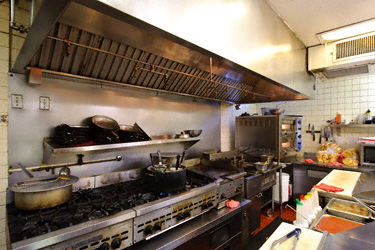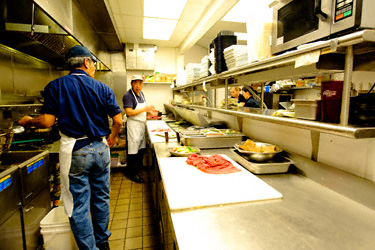 It's hard to realize how important commercial kitchen design is until you work in one that has been designed poorly. A kitchen with a smart design makes work flow easily and prevents unnecessary bottlenecks and interruptions.
It's hard to realize how important commercial kitchen design is until you work in one that has been designed poorly. A kitchen with a smart design makes work flow easily and prevents unnecessary bottlenecks and interruptions.
Aspects of a Commercial Kitchen Layout
When planning the layout for your commercial kitchen, there are several factors you need to consider.
*Available Space. Available space is an important consideration regardless of whether you are building from the ground up or placing your commercial kitchen in an existing building. Either way, you want to make the most of your available space without sacrificing work flow or speed. A general rule is to allow five square feet of kitchen space for every seat in your restaurant, so a 60-seat restaurant will need at least a 300 square foot kitchen.
*Employee Mobility. A well-arranged commercial kitchen will allow employees to easily move around without bumping into one another. This is vital to maintaining a smooth-running kitchen, especially during rush periods.
Health Codes. Local health codes have certain stipulations when it comes to commercial kitchen layout and design.
*Ergonomics. The theory behind ergonomics is that the fewer steps your employees need to complete a task, the better. An ergonomically designed commercial kitchen is one where employees can stand in one spot and do all of their work with minimal bending, reaching, walking or turning. Ergonomics can also reduce the amount of injury, discomfort and fatigue in the kitchen.
*Energy Efficiency. Energy efficiency should be a primary consideration for any commercial kitchen layout, because it saves money on utility costs. In an energy-efficient setup, refrigeration and cooking equipment are kept as far apart as possible while still being practical. Also, cooking equipment is strategically placed to maximize the efficiency of the exhaust hood.
*Sensory Appeal. Beyond appetizing smells, kitchen layout can appeal to customers’ other senses as well. Exhibition kitchens, for example, allow customers to see everything that’s going on.
*Flexibility. Regardless of the final layout, flexibility of design is important for any commercial kitchen. A change in management or food trends could completely change the menu, which can affect equipment usage and placement. Beyond that, make sure the equipment can be easily moved for cleaning.
Kitchen Arrangement
There is no definite rule on how to arrange your commercial kitchen equipment. It all depends on the available space and your particular needs. However, there are four different arrangements that are common.
*Ergonomic Configuration. In a purely ergonomic configuration, the kitchen equipment is arranged according to what is most comfortable and efficient for the chef and kitchen workers and is usually less energy efficient. For example, an ergonomically arranged kitchen might have an undercounter freezer located directly beside the commercial deep fryer. Although this is not energy-efficient, it allows frozen French fries or chicken strips to be moved directly from the freezer to the fryer, without even taking a step.
*Assembly-Line Configuration. This design is ideal for a restaurant that mostly produces large quantities of the same foods, like pizzas or sandwiches. In an assembly-line configuration, the kitchen is laid out according to the order of use, and the pieces of equipment are generally in a line and are sometimes linked together battery-style. For example, a pizza shop might start with the commercial refrigerator, move to the dough-shaping area, then to the pizza prep table, then to the pizza deck oven and finally to the warming and holding station or pizza box.
*Zone-Style Configuration. In a zone-style configuration, the kitchen is divided into different zones or blocks. Generally, there is a block for food preparation, a block for cooking, a block for refrigeration and ice machines, a block for sanitation and ware-washing and a block for the kitchen-to-server transition. There may even be multiple blocks. For example, a large kitchen may need two food preparation blocks: one near the refrigeration and one near the cooking equipment.
*Island-Style Configuration. Island-style kitchens are popular in both the residential and commercial settings. It is similar to the zone-style configuration but there is one main block in the middle. Typically, commercial kitchens with an island-style configuration place the cooking equipment in the middle with the food prep, storage and kitchen-to-server transition areas on the outer walls. The reverse is also common, with prep equipment in the center and cooking equipment on the outer walls.
How to Group Equipment
Each kitchen will have different equipment. So, you will need to tailor your equipment layout to your restaurant’s needs. For a more detailed overview of how to group your equipment, check out the following articles:
Commercial Kitchen Layout Assistance
Laying out and organizing a commercial kitchen is a difficult task. Unless you've done it before, it's a good idea to get help. There are people who specialize in designing and laying out commercial kitchens. A restaurant designer, interior designer with restaurant-design experience or a restaurant design firm are a few resources. You can also ask your restaurant equipment dealer; he or she may have a little experience laying out commercial kitchens.
Every kitchen is different. Determine what your priorities are, and choose a design that will accommodate them and works well with your menu. Otherwise, you might end up having to make costly renovations to your kitchen layout.

Restaurants will usually have food prep equipment positioned in various places throughout the kitchen area. Generally, there is a dedicated food prep area where raw ingredients are sliced, diced and mixed before they go to the cook line, but the cook line itself may have a refrigerated prep table and a couple of commercial work tables on it to for workers to quickly prepare sandwich buns before handing them to the chef.
As far as general placement goes, prep tables and work tables can be placed wherever needed. However, here are some general tips on arranging your food preparation equipment:
*Try to keep refrigerated prep tables separate from cooking equipment. This is where you need to balance function with energy efficiency. A refrigerated prep table right next to the griddle is a great way to assemble hamburgers right as the patties come off the grill, but that will just kill the energy efficiency of both pieces of equipment. To save the most money, place the prep table behind or across from the griddle, so workers can exchange buns and burgers without taking any steps or running up your energy bill.
*Match the heights. When placed in line with other equipment, worktables should be the same height as the countertop or the top of your cooking equipment, such as your range or griddle. Having everything at the same height is ergonomic and facilitates an assembly-line process.
*Try undercounter or worktop cooling. If you don’t need a refrigerated prep table with an ingredient rail, but still want cooling equipment on your prep line, consider undercounter or worktop refrigerators and freezers. They save space and labor by combining your refrigeration area with your prep area and also reduce trips to the walk in cooler.





 Cart (0)
Cart (0)